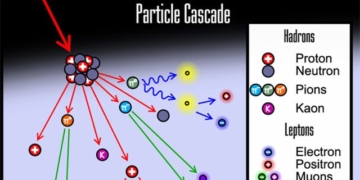A Chinese shipbuilding company has introduced an advanced design for a super container ship powered by a zero-emission nuclear reactor.
If produced, the KUN-24AP vessel, unveiled by KUN-24AP Shipbuilding Company in Shanghai at the recent Marintec China exhibition, would be one of the largest container ships in the world, with a capacity of 24,000 standard containers. This is also the first super container ship to utilize a molten salt nuclear reactor, as reported by Maritime Executive on December 5th.

First container ship design using a thorium reactor. (Photo: Weibo).
Unlike nuclear reactors on naval vessels that operate using uranium, the new reactor is likely to utilize abundant and cost-effective radioactive metal known as thorium, which is readily available in China. This reactor does not require large amounts of water for cooling, making it safer and more efficient. However, the technology is highly complex, and many countries, including the United States, have ceased development after decades without promising results.
Earlier this year, China operated its first thorium-based molten salt reactor in the Gobi Desert. Scientists involved in the project stated that such reactors could be installed anywhere, including on ships, and their small size allows for various applications. The introduction of a container ship prototype indicates China’s strong confidence in the technology and its readiness to present it to the world.
The DNV Classification Society, one of the leading international organizations in the maritime sector, has certified the design of the KUN-24AP ship. The vessel uses nuclear energy as a clean power source and incorporates fourth-generation molten salt reactor technology. The proposed design of this super-large nuclear container ship is truly emission-free throughout its operational cycle, according to Maritime China magazine.
China is not the first country to unveil such a design. Shipbuilding companies in Japan, the United States, South Korea, and Europe have also proposed similar designs. However, their prototypes are significantly smaller, and none of the aforementioned countries have a modern and reliable reactor capable of turning these designs into reality. China’s shipbuilding industry has been rapidly expanding in recent years, accounting for over 60% of global order volume.




















































